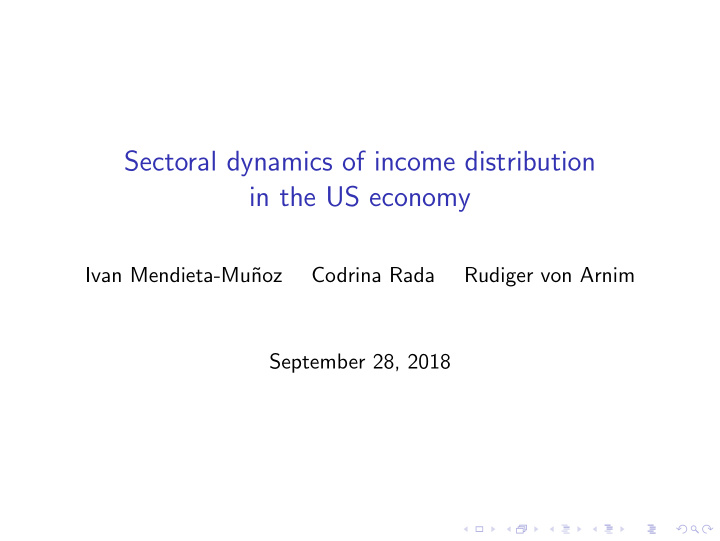



Sectoral dynamics of income distribution in the US economy Ivan Mendieta-Mu˜ noz Codrina Rada Rudiger von Arnim September 28, 2018
The project in a nutshell
The project in a nutshell Stagnation & inequality: US economy is characterized by a slowdown in average real GDP and labor productivity growth, as well as decline in the labor share. How do these macroeconomic phenomena manifest at the sectoral level? Divisia index decomposition of the labor share across sectors points towards “reverse–Lewis,” rather than Baumol , as the relevant narrative.
Baumol’s cost disease as reference point 2–sector economy with differential productivity growth rates. Baumol assumes labor homogeneity, mobility, and competition ⇒ no change in distribution . Structural change: employment share in services rises: ◮ Stagnation: aggregate productivity growth is decreasing ... ◮ ... with a constant labor share : aggregate real wage growth = aggregate labor productivity growth. ◮ But: relative price of services increases!
Baumol’s cost disease as reference point Baumol (2012): “[N]o matter how painful rising medical and educational bills may be, society can afford them , and there is no need to deny them to ourselves or to the less affluent [...]. Overall incomes and purchasing power must rise quickly enough to keep these services affordable, despite their persistently rising costs.” True, if the distribution of income does not change , and gains in high–productivity sectors are widely shared!
Reverse–Lewis, rather. But: labor share secularly declines since (at least) 1980. Re–dualization is characterized by: ◮ labor shedding in high–productivity activities, ◮ surplus labor absorption in low–productivity activities, ◮ and no need to offer high wages in the latter : labor is not homogeneous, not mobile, and labor markets are not clearing! Temin’s “Vanishing middle class” (2017); Storm’s “New normal” (2017); Taylor & ¨ Omer’s “Race to the bottom” (2018).
Methodology: Divisia index decomposition US labor share ( ψ ), 1987–2016, 14 sectors, decomposed into ◮ real compensation ω i , ◮ employment structure λ i ◮ labor productivity ε i and ◮ relative prices p i . n n n � w i L i � w i L i � ω i λ i PL i =1 i =1 i =1 ψ = = = (1) n n n PL � P i X i � P i X i � p i ε i λ i i =1 i =1 i =1
Methodology: Divisia index decomposition φ i : Nominal compensation share of sector i θ i : Nominal value added share of sector i � = exp[ ( φ i , t + φ i , t − 1 ) / 2 ln( ω i )] D comp � D empl = exp[ [( φ i , t + φ i , t − 1 ) / 2 − ( θ i , t + θ i , t − 1 ) / 2] ln( λ i )] � = exp[ ( θ i , t + θ i , t − 1 ) / 2 ln( p i )] D price � = exp[ ( θ i , t + θ i , t − 1 ) / 2 ln( ε i )] D techn ⇒ Decomposition shows contributions of 4 components in 14 sectors to percentage change of aggregate wage share over sample period .
Results: Overview, I
Results: Overview, II
Results: Overview, III
Contributions to ∆ ψ/ψ : Four components, 1987–2016
Contributions to ∆ ψ/ψ : Four components, by year
Contributions to ∆ ψ/ψ : Fourteen sectors, 1987–2016
Contributions to ∆ ψ/ψ : Real wages & productivity
Contributions to ∆ ψ/ψ : Employment & relative prices
Structural change: 1987–2016
Concluding question marks
Recommend
More recommend